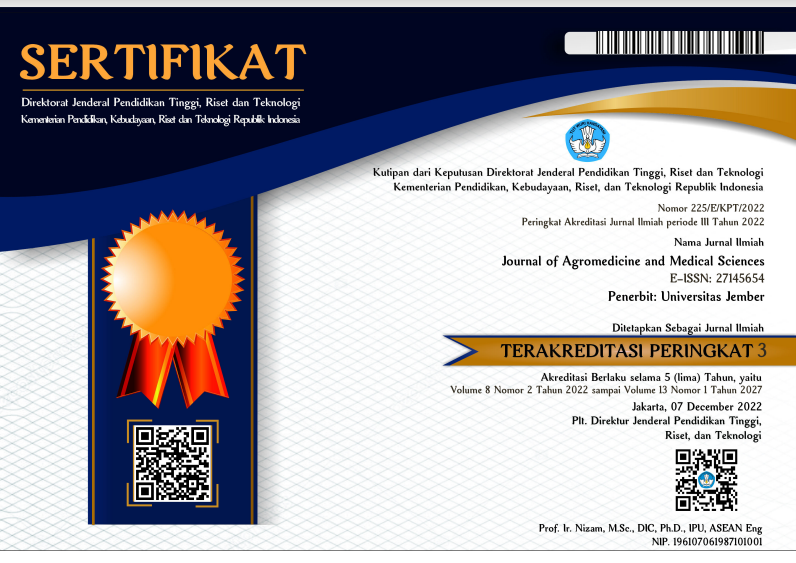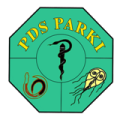The Correlation Between Mother's Knowledge about Complementary Feeding with The Incidence of Stunting in Toddlers Under Two in Mayang, Jember
DOI:
https://doi.org/10.19184/ams.v8i2.25606Abstract
Stunting is a condition of toddlers who have a height-for-age less than -2 SD WHO Z-score. The period from a newborn until two years is also known as the golden period. Nutrition obtained after birth affects the growth and development of them. Complementary feeding was given when they were 6 months old. The level of mother's knowledge about complementary foods has an impact on complementary feeding. Inappropriate complementary feeding can lead to stunting. The research objective was to determine the correlation between mother's knowledge about complementary feeding and the incidence of stunting in toddlers under two in Mayang. The research was an analytical observational with a cross sectional study design. The sample was 90 respondents taken using consecutive sampling method. Data collection using a questionnaire on the mother and using height-for-age data from the toddlers. Statistical test using the Spearman test, showed that there was a significant correlation between the level of mother's knowledge about complementary feeding and the incidence of stunting (p=0.024.; rho=-0.238). Due to this result, we recommend continuous health promotion and education among mothers to decrease the risk of stunting in their children.
Keywords: stunting, complementary feeding, toddlers under two, mother’s knowledge
Downloads
References
Beal, T., Tumilowicz, A., Sutrisna, A., Izwardy, D., & Neufeld, L. M. (2018). A review of child stunting determinants in Indonesia. Maternal & child nutrition, 14(4), e12617. https://doi.org/10.1111/mcn.12617
Fanta, M., & Cherie, H. A. (2020). Magnitude and determinants of appropriate complementary feeding practice among mothers of children age 6-23 months in Western Ethiopia. PloS one, 15(12),e0244277. https://doi.org/10.1371/journal.pone.0244277
Farapti, Damayanti, R.A., Muniroh, L. (2016). Differences in Consumption patterns and History of Infection in Stunting and Non Stunting Children. Adi Husada Nursing Journal, 2(2), 61-68.
https://adihusada.ac.id/jurnal/index.php/AHNJ/article/view/58
Hasibuan, Y., Batubara, A., & Suryani, S. (2019). Mother’s Role and Knowledge in Young Children Feeding Practices on the Nutritional Status of Infant and Toddler. Global Journal of Health Science, 11(6), 158. https://doi.org/10.5539/gjhs.v11n6p158
Indrastuty, D., Pujiyanto, P,. (2019). Household Socio-Economic Determinants of Stunting Toddlers in Indonesia: Data Analysis of the Indonesia Family Life Survey (IFLS) 2014. Indonesian Journal of Health Economics, [Sl], v. 3, n. 2, june 2019. ISSN 2598-3849. http://dx.doi.org/10.7454/eki.v3i2.3004
Jember District Health Office. (2018). Incidence of Stunting and Malnutrition in Jember Regency. Jember: Jember District Health Office.
Kardyanti, N., Suyatno, S., & Kartasurya, M. I. (2021). Correlation between Breastfeeding and Complementary Feeding Patterns with Children Under Two Nutrition Adequacy in Fisherman’s Family. Jurnal Kesehatan Masyarakat (Undip), 9(5), 621-626. https://doi.org/10.14710/jkm.v9i5.30619
Li, Z., Kim, R., Vollmer, S., & Subramanian, S. (2020). Factors Associated With Child Stunting, Wasting, and Underweight in 35 Low-and Middle-Income Countries. JAMA Netw Open, 3(4). https://doi.org/10.1001/jamanetworkopen.2020.3386
Ministry of Village PDTT. (2017). Village Pocket Book in Handling Stunting. Jakarta: Ministry of Villages, Development of Disadvantaged Regions and Transmigration
Mukharromah, H. L., Kusmiyati, Y., & Margono, M. (2017). Young maternal age correlation with Emotional Development in children aged 3-5 years in Sewon II Public Health Center, Bantul District. Jurnal Kesehatan Ibu Dan Anak, 11(2),p 92–97.
https://doi.org/10.29238/kia.v11i2.36
Onis, M. De, Borghi, E., Arimond, M., Webb, P., Croft, T., Saha, K., De-regil, L. M., Thuita, F., Heidkamp, R., Krasevec, J., Hayashi, C., & Flores-ayala, R. (2018). Prevalence thresholds for wasting, overweight and stunting in children under 5 years. Public Health Nutrition. 4, 1–5. https://doi.org/10.1017/S1368980018002434
Pratasis, NN, Malonda, N.S.H., Kapantow, N.H. (2018). The Relationship Between Maternal Characteristics and Nutritional Status of Toddlers in Ongkaw Village, Sinonsayang District, South Minahasa Regency. Kesmas. V.7 n.3 https://ejournal.unsrat.ac.id/index.php/kesmas/issue/view/2193
Puspasari, N. and Andriani, M. (2017). Relationship of mother's knowledge about nutrition and food intake of toddlers with nutritional status of toddlers (W/U) aged 12-24 months. Journal of Amerta Nutr. 1(4): 369-378. Doi:http://dx.doi.org/10.20473/amnt.v1i4.2017.369-378
Rakhma, L.R., Erlinda F., Apriliana, W.F. (2017). Correlation Of Education Level to Mother’s Knowledge Following Therapeutic Feeding Center (Tfc) Program in Sukoharjo Central Java. Preventif. v.8.n.2m p 66-72. http://jurnal.untad.ac.id/jurnal/index.php/Preventif/article/view/9401
Ramadhana, PV., Abdullah, A., Aramico., B. (2019). Differences in Nutritional Status in Infants who are Exclusively Breastfed and Early Breastfeeding in the Work Area of the Public Health Center of Jantho City, Aceh Besar District, 2017. Aceh Public Health Journal. Vol 5, No 1 (2019)
https://doi.org/10.37598/jukema.v5i1.702
Rukmana, E., Briawan, D. & Ekayanti, I. (2016). Risk Factors for Stunting in Children Age 6-24 Months in Bogor City. The Indonesia Journal of Public Health. V. 12.n 3. P 192-199. https://journal.unhas.ac.id/index.php/mkmi/article/view/1081
Samman, S., Alim, A., Muslimin, B. (2020). Qualitative Study: Mother’s Behaviour towards Exclusive Breastfeeding in Banemo Public Health Center, District of Central Halmahera. Media Penelitian dan Pengembangan Kesehatan, Vol. 30 No. 2, p 163–182.
https://doi.org/10.22435/mpk.v30i2.2397
Scaglioni, S., De Cosmi, V., Ciappolino, V., Parazzini, F., Brambilla, P., & Agostoni, C. (2018). Factors influencing children's eating behaviors: A review. Nutrients. MDPI. https://doi.org/10.3390/nu10060706
Sethi, R., Padhy, S., & Raju, D. (2017). Knowledge, attitude and practices regarding complementary feeding among mothers of children 6 to 24 months of age in Konaseema region. International Journal of Contemporary Pediatrics, 4(2), 394-398.
http://dx.doi.org/10.18203/2349-291. ijcp20170451
Setyawati, VAV, Ramadha F. (2020). Effect of Planned Family Village on Stunting Nutrition Intervention in Janegara Village. Jurnal Gizi Indonesia. V. 9.n.1, p 42-47.
https://ejournal.undip.ac.id/index.php/jgi/article/view/30424/18466
Shrestha, S., Pokhrel, M., & Mathema, S. (2020). Knowledge, Attitude and Practices among Mothers of Children 6 to 24 months of Age Regarding Complementary Feeding. Journal of Nepal Medical Association, 58(230),758–763. https://doi.org/10.31729/jnma.5274.
Sundari, S.S., Nuryuniarti, R., Kurniawati, A. (2019). Health Education in Pregnant Women about “1000 first days of life for a better generationâ€. ABDIMAS UMTAS Vol. 1 No. 1, p 7-13.
https://doi.org/10.35568/abdimas.v1i1
Widyawati, W. (2016). The Relationship between Mothers and Toddler Knowledge Levels about Complementary Foods for Breastfeeding with Nutritional Status of Toddlers Age 6-24 Months in Semanggi Village, Pasar Kliwon District, Surakarta City. Essay. Faculty of Health Sciences, Muhammadiyah University, Surakarta























